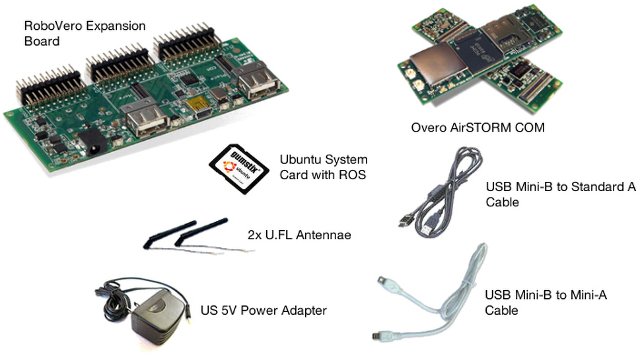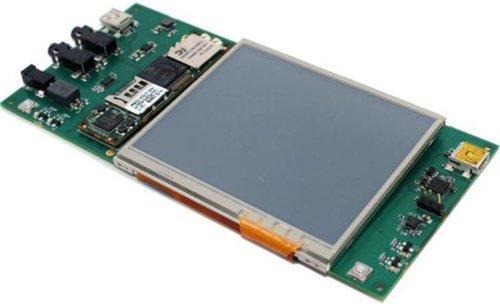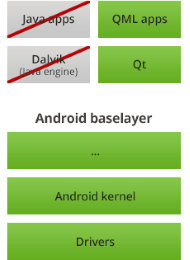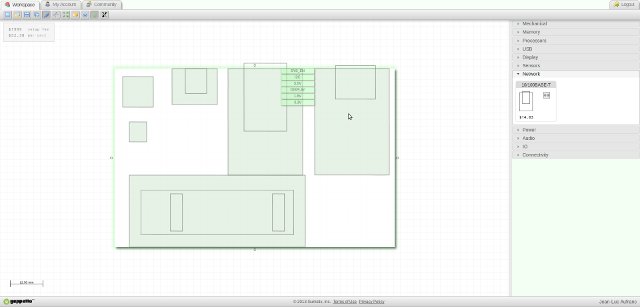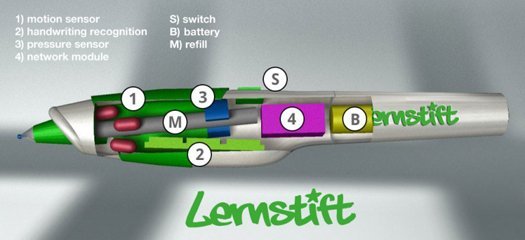Gumstix has recently unveiled several solution kits featuring their Overo and DuoVero Computer-on-Modules (CoMs), Pepper single board computer, and several expansions boards, together with required accessories, and software packages, in order to help their customers getting started more easily. All these solutions are based on Texas Instruments OMAP3, OMAP4, and/or Sitara processors, and run Linux (Ubuntu or Yocto), and sometimes Android for the kits with displays. The solutions kits target 6 different types of applications and/or markets: Robotics Robotic Development Kit (Pictured above) with one Overo AirSTORM CoM (OMAP3703), and RoboVero expansion board. The kit is better suited for motor control applications. Mobile Robotic Development Kit with one Overo AirSTORM CoM, and Turtlecore expansion board to be used with iRobot Create. The kits ship with a Linaro (Ubuntu for Overo) system card and Robot Operating System (ROS) pre-installed. Handhelds 3.5″ Handheld Development Kit featuring Overo AirSTORM CoM with Alto35 cutomizable […]
Lernstift Digital Pen Hits Kickstarter for $150
Lernstift is a digital pen running Linux that aims at helping children learning how to write by vibrating when they’ve made calligraphy or orthography errors. I’ve covered the overall concept in an earlier post, which you can read for details. The company has made some progress, and they have just launched a kickstarter campaign where you can pledge 99 GBP (about $150) to receive the pen later this year or in early 2014. We do know a little more technical details. The first prototype was based on Gumstix Overo (TI OMAP3 or Sitara), but they are now working to design a custom board based on the platform for the final design. The pen comes with 128 MB RAM and runs embedded Linux. In order to gather handwriting data, Lernstift leverages a motion sensor that combines gyroscope with accelerometer, and adds a magnetometer. They’ve got a drawing with Freescale MMA9950L, but […]
Gumstix Alto35 Customizable Touchscreen Board
A few months ago, Gumstix introduced Geppeto, a web platform that allows you to design and order your own baseboard for Gumstix Overo systems-on-module within minutes. The company has just announced Alto35, an expansion board built entirely with Geppetto. The Alto35 replaces Palo35 Overo-series expansion board with the same features, but adding the possibility of customizing the board via Geppetto. Alto34 expansions board features the following: 3.5″ LCD resistive touch screen Stereo audio in/out jacks 3D accelerometer (STMicro LIS33DE) RC servo USB – 2x USB mini-B ports, including console port (FT232RQ USB UART) LEDs in 4 different colors, 2 tactile switches. 2×70-pin AVX Headers compatible with Overo COMs. Power – 3.5V-5V All Overo computers-on-module are compatible with Alto35 board, so you can just use existing software solutions such as Linaro Ubuntu, Robot Operating System, and the Yocto Project. Alto35 is available for $89 including the display (not the Overo module), […]
Linaro 13.05 Release With Linux Kernel 3.10, Android 4.2.2, and Ubuntu Raring Ringtail
Linaro 13.05 has just been released with Linux Kernel 3.10-rc2 and Android 4.2.2. This is the first release with Ubuntu 13.04 (Raring Ringtail) images. There’s also Linux Linaro Stable (LSK) preview based on kernel 3.9.4. BeagleBone Black support has been added and preliminary hwpack and images are available, an Android Arndale image with virtual framebuffer is also available. You can now get a desktop environment (XFCE) on Aarch64 / ARMv8. Hardware packs with Real-time Linux kernel (PREEMPT_RT) can be downloaded for Pandaboard and Arndale. More work has gone into Aarch64, big.LITTLE HMP, and ARM virtualization (KVM). Finally an UEFI is available not only for Vexpress boards, but also Samsung Origen and Arndale boards, as well as Texas Instruments Pandabord and Beagleboard. Here are the highlights of this release: LAVA First prototype production run of LAVA Lmp completed, tested functional. Beaglebone Black is now running in LAVA. TC2s is now running […]
Digia Brings Qt to Embedded Android Devices with Boot to Qt
Digia has recently announced Boot to Qt Technology Preview, a commercial offering that provides a solution for the creation of user interfaces on embedded systems. For the first version, they stripped out Android of Java, or other unnecessary parts (Zygote, SurfaceFlinger), added Qt/QML, and tested it on on ARM and x86 hardware. Boot to Qt includes the following main features: A light-weight UI stack for embedded Linux, based on the Qt Framework – Boot to Qt is built on an Android kernel/baselayer and offers an elegant means of developing beautiful and performant embedded devices. Ready-made images – We have images for several different devices which include the Boot to Qt software stack, making it possible to get up and running with minimal effort from day one. Full Qt Creator Integration – One-click deploy and run on hardware and a fully featured development environment. Simulator – A VirtualBox based simulator which allows device development […]
Gumstix Introduces Geppetto Web Platform to Design Custom Embedded Boards
Gumstix, the company behind the Overo computers-on-module (COMs), has recently announced an online platform called Geppetto that allows anybody with a proper web browser (e.g. Chrome or Firefox) to design and order a complete baseboard for the Overo COMs. You don’t need to know anything about schematics, PCB layout, or other lecrtical engineering knowledges. The program lets you set the board size, add modules (e.g. USB, HDMI, Ethernet…) as you wish, tells you which connections are required, and once the board is done, you can see your 3D rendered board. You can then save it to the cloud with an option to share it with the community, and you can just order it. The learning curve is very short, and once you know how to use it, it probably takes around 10 minutes to design a complete board. Your fearless CNXSoft had to give it a try… First, point your […]
Lernstift – Linux Based Learning Digital Pen
Lernstift UG, a German startup, is working on a digital pen, called Lernstift as well, that can help children learning how to write by vibrating in case of errors. The Lernstift can be used in 2 modes: Calligraphy Mode – Pointing out flaws of form and legibility. Orthography Mode – Detecting orthographic (1 vibration) and grammatical (2 vibration) mistakes. Since it features a ballpoint, it can be used as a real pen, you know to write on paper…, but you can also write in the air, so I suppose they’ll also make a version without ballpoint, so that kids can enjoy one of their favorite pastimes: writing on the walls! The pen features a CPU module (2) that’s used to handle handwriting recognition, gather data from the motion (1) and pressure (3) sensors, and manage the Wi-Fi module (4). A battery, a power switch, and a pen refill complete Lernstift […]
Embedded Linux Conference 2013 Schedule
The Embedded Linux Conference (ELC 2013) will take place on February 20 – 22, 2013 at Park 55 Hotel in San Francisco, California. ELC consists of 3 days of presentations, tutorials and sessions. There will be over 50 sessions during those 3 days. I’ll highlight a few sessions that I find particularly interesting, and that did not get presented at ELCE 2012 (AFAICR). February 20 11:00 – Anatomy of the arm-soc git tree by Olof Johansson, Google We are now two years into the new maintainer model for ARM platforms, and we have settled down into a workflow that maintainers have adjusted well to. Still, when new platforms arrive, or when maintainer ship changes hands, there’s sometimes a bit of ramp-up in getting used to how we organize our git tree and how we prefer to see code submitted to fit that model. This presentation will give an overview of […]


